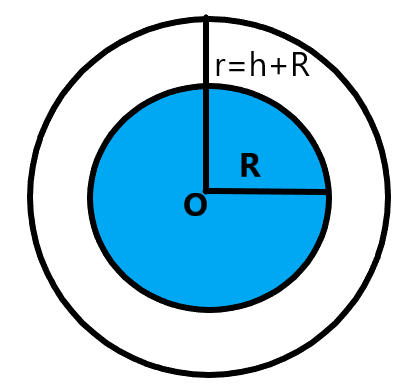
If velocity of a satellite is half of escape velocity, then distance of the satellite from earth surface will be –
A) 6400 km
B) 12800 km
C) 6400\[\sqrt{2}\]km
D) \[\dfrac{6400}{\sqrt{2}}\]km
Answer
558.3k+ views
Hint: We need to find the formulae for the escape velocity of an object from the earth and the velocity of a satellite in an orbit of the earth. From those formulas we can relate the required distance from the earth to the satellite in this case.
Complete answer:
We know that the escape velocity of a planet is defined as the minimum velocity required for an object within the gravitational field of the planet to escape into space. It is dependent on the radius of the planet, the mass of the planet and the gravitational constant ‘G’. The escape velocity is given as –
\[{{v}_{e}}=\sqrt{\dfrac{2GM}{R}}\]
Where, M is the mass of the planet and R is the radius of the planet.

Now, we know that an object which is revolving around a planet within the gravitational field of the planet is supposed to have a maximum velocity beyond which the object will get thrown into the space. This is balanced by the gravitational force offered by the planet and the centripetal force of revolution. We define it as the orbital velocity of the satellite. We can write it as –
\[{{v}_{o}}=\sqrt{\dfrac{GM}{r}}\]
Where, r is the distance between the center of the planet and the satellite.
From the above two relations, we can get the relation between the ‘r’ and the ‘R’ for the planet earth.
It is given that the orbital velocity of the satellite is half the escape velocity.
If the distance from the surface to the satellite is ‘h’ and the radius of the earth is 6400km. Then,
\[\begin{align}
& {{v}_{o}}=\dfrac{{{v}_{e}}}{2} \\
& \Rightarrow \sqrt{\dfrac{GM}{r}}=\dfrac{1}{2}\sqrt{\dfrac{2GM}{R}} \\
\end{align}\]
\[\begin{align}
& \Rightarrow r=2R \\
& \text{but, }r=h+R \\
& \therefore h=R=6400km \\
\end{align}\]
This is the required solution.
The correct answer is option A.
Note:
The kinetic energy of a satellite needs to be reduced as it moves from a nearer orbit to a farer orbit in order to keep the satellite in orbit. The velocity of the satellite moving around the planet is lowered in order to achieve this criterion as they are related directly.
Complete answer:
We know that the escape velocity of a planet is defined as the minimum velocity required for an object within the gravitational field of the planet to escape into space. It is dependent on the radius of the planet, the mass of the planet and the gravitational constant ‘G’. The escape velocity is given as –
\[{{v}_{e}}=\sqrt{\dfrac{2GM}{R}}\]
Where, M is the mass of the planet and R is the radius of the planet.

Now, we know that an object which is revolving around a planet within the gravitational field of the planet is supposed to have a maximum velocity beyond which the object will get thrown into the space. This is balanced by the gravitational force offered by the planet and the centripetal force of revolution. We define it as the orbital velocity of the satellite. We can write it as –
\[{{v}_{o}}=\sqrt{\dfrac{GM}{r}}\]
Where, r is the distance between the center of the planet and the satellite.
From the above two relations, we can get the relation between the ‘r’ and the ‘R’ for the planet earth.
It is given that the orbital velocity of the satellite is half the escape velocity.
If the distance from the surface to the satellite is ‘h’ and the radius of the earth is 6400km. Then,
\[\begin{align}
& {{v}_{o}}=\dfrac{{{v}_{e}}}{2} \\
& \Rightarrow \sqrt{\dfrac{GM}{r}}=\dfrac{1}{2}\sqrt{\dfrac{2GM}{R}} \\
\end{align}\]
\[\begin{align}
& \Rightarrow r=2R \\
& \text{but, }r=h+R \\
& \therefore h=R=6400km \\
\end{align}\]
This is the required solution.
The correct answer is option A.
Note:
The kinetic energy of a satellite needs to be reduced as it moves from a nearer orbit to a farer orbit in order to keep the satellite in orbit. The velocity of the satellite moving around the planet is lowered in order to achieve this criterion as they are related directly.
Recently Updated Pages
Master Class 11 Chemistry: Engaging Questions & Answers for Success

Why are manures considered better than fertilizers class 11 biology CBSE

Find the coordinates of the midpoint of the line segment class 11 maths CBSE

Distinguish between static friction limiting friction class 11 physics CBSE

The Chairman of the constituent Assembly was A Jawaharlal class 11 social science CBSE

The first National Commission on Labour NCL submitted class 11 social science CBSE

Trending doubts
What is meant by exothermic and endothermic reactions class 11 chemistry CBSE

10 examples of friction in our daily life

One Metric ton is equal to kg A 10000 B 1000 C 100 class 11 physics CBSE

Difference Between Prokaryotic Cells and Eukaryotic Cells

What are Quantum numbers Explain the quantum number class 11 chemistry CBSE

1 Quintal is equal to a 110 kg b 10 kg c 100kg d 1000 class 11 physics CBSE




